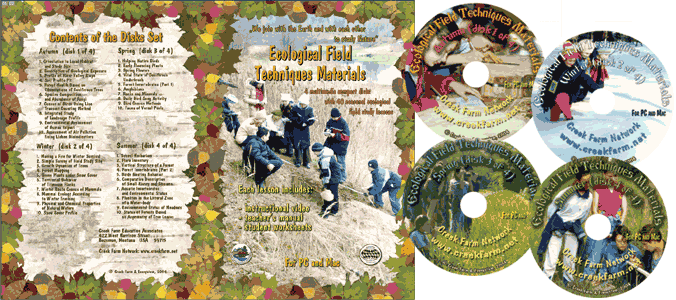|
| Our Field Ecology Center published more than
180 methodical materials for nature studies. Some of them are in English: |
|
|
|
Methods of Observation of a Chickadee Flock's Territorial Behavior
© Alexsander S. Bogolyubov,
Russia, 2001
© Michael J. Brody, USA,
2003
 This manual describes a procedure
for observing the territorial behavior of birds of mixed chickadee flocks during autumn
and winter. The main of goal is to track the flockТs movement within the forest, mapping
speed and direction on the flockТs route. This data is used for determining the feeding
territory of this flock. This manual describes a procedure
for observing the territorial behavior of birds of mixed chickadee flocks during autumn
and winter. The main of goal is to track the flockТs movement within the forest, mapping
speed and direction on the flockТs route. This data is used for determining the feeding
territory of this flock.
This field study has instructional video
featuring real students conducting the ecological field techniques in nature. Each video
illustrates the primary instructional outcomes and the major steps in accomplishing the
task including reporting the results.
Introduction
The study of non-nesting biology of the birds forming mixed chickadee flocks in the
forested zone is one of the favorite and most popular topics of individual research of
young zoologists.
Mixed chickadee flocks potentially include 10-15 species of small-sized forest
birds in Russian forests. They include: 1) chickadee flocks, 2) great tit,
3) blue tit, 4) crested tit, 5) coal tit. In the north wood zone the Siberian
tit enters chickadee flocks, in the south and west in broad-leaved forests Ц the willow
tit. Besides these basic species, some species, which do not belong to the chickadee
family, are, however "full" members of chickadee flocks: 6) goldcrest, 7)
bottle tit (long-tailed tit) 8) pika, and 9) nuthatch. Moreover, some
"accompanying" species are also met in chickadee flocks: 10) great spotted
woodpecker 11) lesser-spotted woodpecker (barred woodpecker) and, sometimes the
three-toed woodpecker. Woodpeckers, as a rule, enter chickadee flocks for short
periods of time Ц while the flock, migrating along the forest, passes through
woodpeckerТs habitat.
Study of a chickadee flock's biology can be a very rewarding subject for the individual
studies of schoolchildren. First, this study does not require great knowledge of all
wintering bird species (as for example, a bird census) Ц only two or up to six species
are to be determined, which are distinctive at long-term observations. Second, the
procedure of observations is simple and does not require great attention or practical
skills. Third, observations of chickadee flocks train student attention, teaching how to
visually identify birds in nature. Fourth, while observing, pupils have a chance "to
get closely introduced" to studied species, as long-term observed birds get used to
people and begin to let them come nearer (up to 1 meter). Fifth, when studying the route
of the flockТs migrations in the forest, pupils learn to work with a map, define
distances on location and determine directional orientation. Last, observations of
chickadee flocks use inherent Уhunting excitement."
All of the above allow teachers to use an elementary procedure of mapping a chickadee
flock's territorial movement in the forest with children in nature. The goal of this study
is to mark the habitat (territory) of a chickadee flock on the map and study the
peculiarities of the flock's (as a formed group) behavior.
General Information
Period of observations
Observations of the biology of birds that form mixed chickadee flocks are possible
during a large part of year - from July until March or April.
Only a short nesting period is excluded from the potential observation time. At this
time, flocks get separated because birds form pairs. But when young birds first fly out at
the end of the reproductive period, observations become possible again.
The best time for organizing an observation of a flock's territorial behavior is
late autumn and winter (November - February). At this time, birds form groups that are
consistent in structure and, which is very important, in constant territories. The size of
these territories depends on forest type, and varies from 5 up to 50 hectares in central
Russia. Therefore, observation of the flocks are not as laborious as in summer or early
autumn, when birds migrate for long distances and the process of observation can turn out
to be quite physically difficult as birds move in the forest with different speeds (either
slowing down or accelerating). Besides, in early autumn not all flocks have their
"constant" sites, (as, for example, in winter) and some attempts to trace a
flock in the forest can be unsuccessful.
There is one more advantage of the fall/winter period; it is rather warm weather,
therefore children can work with a map and record data without getting too cold (which is
a greater problem in winter). Lack of deep snow cover also makes moving in the forest ...
This was only the first page from the manual and its full version you can see in the
Ecological Field Studies Techniques Video 4CD Set:
It is possible to purchase the complete set of 40 seasonal Ecological Field
Studies Techniques Video (in mpg format) in an attractive 4 compact disk set.
These compact disks are compatible with Mac and PC computers.
The videos are suitable for individual student or whole class instruction. To purchase the complete 4CD set
write to ecosystema1994@yandex.ru in a free form.

Ecological Field Studies Demo Disk:
We also have a free and interesting demonstration disk that explains our ecological field studies approach.
The demo disk has short excerpts from all the seasonal field study videos as well as sample text from all the teacher manuals.
The disk has an entertaining automatic walk through which describes the field study approach and explains how field studies meet education standards.
You can also download the Demo Disc from ecosystema.ru/eng/eftm/CD_Demo.iso.
This is a virtual hybrid (for PC and Mac computers) CD-ROM image (one 563 Mb file "CD_Demo.iso").
You can write this image to the CD and use it in your computer in ordinary way.
You also can use emulator software of virtual CD-ROM drive to play the disk directly from your hard disk.

|







